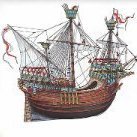-
Posts
1,877 -
Joined
-
Last visited
About Chuck Seiler

Profile Information
-
Gender
Male
-
Location
: San Diego area
-
Interests
Shipmodeling, eh
Recent Profile Visitors
-
 Chuck Seiler reacted to a post in a topic:
2023 Donations drive
Chuck Seiler reacted to a post in a topic:
2023 Donations drive
-
 GrandpaPhil reacted to a post in a topic:
Prince de Neufchatel by Coyote_6 – Constructo – 1/58 scale - American privateer
GrandpaPhil reacted to a post in a topic:
Prince de Neufchatel by Coyote_6 – Constructo – 1/58 scale - American privateer
-
 vvvjames reacted to a post in a topic:
Prince de Neufchatel by Coyote_6 – Constructo – 1/58 scale - American privateer
vvvjames reacted to a post in a topic:
Prince de Neufchatel by Coyote_6 – Constructo – 1/58 scale - American privateer
-
 Coyote_6 reacted to a post in a topic:
Prince de Neufchatel by Coyote_6 – Constructo – 1/58 scale - American privateer
Coyote_6 reacted to a post in a topic:
Prince de Neufchatel by Coyote_6 – Constructo – 1/58 scale - American privateer
-
 Keith Black reacted to a post in a topic:
Prince de Neufchatel by Coyote_6 – Constructo – 1/58 scale - American privateer
Keith Black reacted to a post in a topic:
Prince de Neufchatel by Coyote_6 – Constructo – 1/58 scale - American privateer
-
Steve, You may have to name your endeavors "Steve's Spit and Polish Restorations". I am a little late to the discussion and was going to mention Rob Napier's thoughts on the use of saliva, but Keith beat me. Rob is a well known/well respected restorer who has written about it. Don Dressel can probably tell you more about him, if you have an hour or 3. Have you spoken to Jon Sanford about model cleaning?
-
 Chuck Seiler reacted to a post in a topic:
Prince de Neufchatel by Coyote_6 – Constructo – 1/58 scale - American privateer
Chuck Seiler reacted to a post in a topic:
Prince de Neufchatel by Coyote_6 – Constructo – 1/58 scale - American privateer
-
Chuck Seiler started following What is CA glue and how does it work?
-
 Chuck Seiler reacted to a post in a topic:
Prince de Neufchatel by Coyote_6 – Constructo – 1/58 scale - American privateer
Chuck Seiler reacted to a post in a topic:
Prince de Neufchatel by Coyote_6 – Constructo – 1/58 scale - American privateer
-
 Taken Aback reacted to a post in a topic:
Chris Watton and Vanguard Models news and updates Volume 2
Taken Aback reacted to a post in a topic:
Chris Watton and Vanguard Models news and updates Volume 2
-
 Chuck Seiler reacted to a post in a topic:
Chris Watton and Vanguard Models news and updates Volume 2
Chuck Seiler reacted to a post in a topic:
Chris Watton and Vanguard Models news and updates Volume 2
-
 Chuck Seiler reacted to a post in a topic:
Chris Watton and Vanguard Models news and updates Volume 2
Chuck Seiler reacted to a post in a topic:
Chris Watton and Vanguard Models news and updates Volume 2
-
 Canute reacted to a post in a topic:
Chris Watton and Vanguard Models news and updates Volume 2
Canute reacted to a post in a topic:
Chris Watton and Vanguard Models news and updates Volume 2
-
 hollowneck reacted to a post in a topic:
Chris Watton and Vanguard Models news and updates Volume 2
hollowneck reacted to a post in a topic:
Chris Watton and Vanguard Models news and updates Volume 2
-
 Clark reacted to a post in a topic:
Chris Watton and Vanguard Models news and updates Volume 2
Clark reacted to a post in a topic:
Chris Watton and Vanguard Models news and updates Volume 2
-
 thibaultron reacted to a post in a topic:
Chris Watton and Vanguard Models news and updates Volume 2
thibaultron reacted to a post in a topic:
Chris Watton and Vanguard Models news and updates Volume 2
-
When I first seriously got into wooden ship modeling about 30 years ago, our club was mostly 60, 70 and 80 year olds. They were lamenting that there were very few young people in the hobby and it was dying out. Now, at 71, I sit back and smile. The young folks who were NOT into the hobby back then are the old folks that ARE in the hobby now. In addition, our club has several 20/30-somethings, many 40-somethings and a few pre-teens. The hobby is thriving and with the plethora of resources/kit makers we will be around for a long time. ...Well, at least the hobby.
-
 Chuck Seiler reacted to a post in a topic:
Chris Watton and Vanguard Models news and updates Volume 2
Chuck Seiler reacted to a post in a topic:
Chris Watton and Vanguard Models news and updates Volume 2
-
 Chuck Seiler reacted to a post in a topic:
Prince de Neufchatel by Coyote_6 – Constructo – 1/58 scale - American privateer
Chuck Seiler reacted to a post in a topic:
Prince de Neufchatel by Coyote_6 – Constructo – 1/58 scale - American privateer
-
 Chuck Seiler reacted to a post in a topic:
Prince de Neufchatel by Coyote_6 – Constructo – 1/58 scale - American privateer
Chuck Seiler reacted to a post in a topic:
Prince de Neufchatel by Coyote_6 – Constructo – 1/58 scale - American privateer
-
 Chuck Seiler reacted to a post in a topic:
Prince de Neufchatel by Coyote_6 – Constructo – 1/58 scale - American privateer
Chuck Seiler reacted to a post in a topic:
Prince de Neufchatel by Coyote_6 – Constructo – 1/58 scale - American privateer
-
 Chuck Seiler reacted to a post in a topic:
Prince de Neufchatel by Coyote_6 – Constructo – 1/58 scale - American privateer
Chuck Seiler reacted to a post in a topic:
Prince de Neufchatel by Coyote_6 – Constructo – 1/58 scale - American privateer
-
Your serving looks great. Hopefully I can get a better look-see next week, If you are concerned about it being too thick or bulky, use thinner line. What are you using. I think Toni Levine recommends fly tine in here rigging project. I looked that up once and went thru the various thread size formulas and standards to come up with an appropriate thread...then I dozed off (squirrel). If I remember, I will bring something in next week.
-

Bulwarks
Chuck Seiler replied to sgrez's topic in Building, Framing, Planking and plating a ships hull and deck
You don't indicate whether the bulwark will be planked or not. I would be inclined to NOT use the bulwark provided but instead use 1/16" basswood (using the old bulwarks as templates) then plank over it, inside and out. This would reinforce the basswood in the same manner as 2 ply lamination as suggested by James. If the kit does not supply planking material, 1/32" basswood strips (if planking interior and exterior) or 1/16" BW strips will work. That should be available from hobby shops like Michaels. Another alternative is Alaskan Yellow Cedar. It is soft like basswood but I find it much better as a planking wood. Hobby Mill EU (Europe) and Modelers Sawmill (US) bother carry AYC. Both are MSW sponsors. -
I have never used Vallejo. As mentioned above, I like Windsor and Newton. It mixes well with water and I can vary the consistency. Because I paint small areas, I have come to like the "carriage process" outlined by Chuck Passaro in one of his builds. Winchelsea, I believe. I am told it is so named because that is how they painted fine carriages in days of old. The paint is thinned to sightly thicker than water. The paint is applied and allowed to dry, then buffed between coats. I have found the first 2 coats go on without buffing in between. At first it is very transparent/translucent, but it gets better. Six to eight coats. Its marvelous!!! I have been searching for 'the perfect red' for years. I sometimes will see a great 'barn red' barn while driving. I will stop and take a pic. Cadmium Red Deep and Red Ochre (or sometimes a mix of the two) are what I have settled on.
About us
Modelshipworld - Advancing Ship Modeling through Research
SSL Secured
Your security is important for us so this Website is SSL-Secured
NRG Mailing Address
Nautical Research Guild
237 South Lincoln Street
Westmont IL, 60559-1917
Model Ship World ® and the MSW logo are Registered Trademarks, and belong to the Nautical Research Guild (United States Patent and Trademark Office: No. 6,929,264 & No. 6,929,274, registered Dec. 20, 2022)
Helpful Links
About the NRG
If you enjoy building ship models that are historically accurate as well as beautiful, then The Nautical Research Guild (NRG) is just right for you.
The Guild is a non-profit educational organization whose mission is to “Advance Ship Modeling Through Research”. We provide support to our members in their efforts to raise the quality of their model ships.
The Nautical Research Guild has published our world-renowned quarterly magazine, The Nautical Research Journal, since 1955. The pages of the Journal are full of articles by accomplished ship modelers who show you how they create those exquisite details on their models, and by maritime historians who show you the correct details to build. The Journal is available in both print and digital editions. Go to the NRG web site (www.thenrg.org) to download a complimentary digital copy of the Journal. The NRG also publishes plan sets, books and compilations of back issues of the Journal and the former Ships in Scale and Model Ship Builder magazines.







